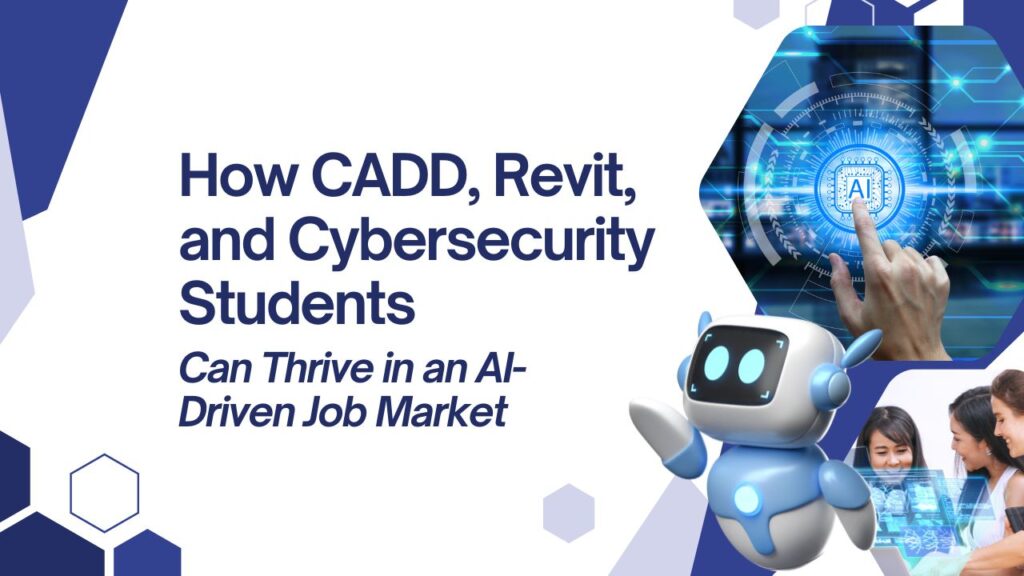
Artificial Intelligence (AI) is no longer just a buzzword—it’s a powerful force reshaping industries across the globe.
From designing buildings to detecting cyber threats, AI is transforming how we work, communicate, and solve problems.
For adult learners and career changers interested in fields like Computer-Aided Drafting and Design (CADD), Revit for Building Information Modeling (BIM), and Cybersecurity, this evolution can feel both exciting and uncertain.
Some fear that AI will eliminate jobs, automating tasks traditionally handled by humans. While it’s true that some roles may change or even disappear, there’s a more optimistic and realistic perspective to consider: AI won’t replace people—it will replace tasks.
Those who learn to use AI tools will be the ones who stay competitive and relevant in the workforce.
In this blog, we’ll explore how AI is already impacting these three fields, how it’s expected to evolve, and—most importantly—how students can prepare to thrive in this new era.
AI’s Role in CADD: Automation Meets Precision
Computer-Aided Drafting and Design (CADD) has always relied on technology. But today’s CADD software is becoming even more powerful thanks to AI integration.
Tasks that once required hours of manual labor can now be accelerated—or even completed automatically—by intelligent tools.
AI can assist with:
- Auto-generating design suggestions based on pre-set parameters
- Spotting inconsistencies or design flaws before human review
- Transforming 2D plans into 3D models in real time
- Learning from user behavior to recommend efficient workflows
So, what does this mean for students in CADD?
It means the focus is shifting. Instead of merely knowing how to use design software, drafters must now understand how to leverage AI to improve speed, accuracy, and output.
Soft skills like critical thinking and adaptability become even more valuable.
Tips for CADD students:
- Get hands-on experience with AI-enhanced design software like AutoCAD or SolidWorks.
- Practice reading and interpreting design data generated by AI.
- Build a portfolio that showcases both manual and AI-augmented drafting work.
AI in Revit and BIM: Smarter Building Design
Revit and Building Information Modeling (BIM) have already revolutionized architecture and engineering by allowing users to design buildings collaboratively in 3D. With AI now part of the picture, BIM is becoming even smarter.
AI in Revit can:
- Optimize building performance by predicting energy use and structural stress.
- Offer data-driven insights on materials, cost, and environmental impact.
- Identify design errors before construction begins, saving time and money.
- Simulate real-world scenarios such as natural disasters or occupancy patterns.
For students working with Revit, AI presents a chance to become not just designers but strategic thinkers who understand both the creative and data-driven aspects of construction.
Tips for Revit students:
- Learn how to incorporate AI features such as performance analytics or generative design.
- Understand how to interpret simulation results and use them to improve designs.
- Keep up with emerging trends like digital twins and smart cities.
AI in Cybersecurity: The Need for Human Intelligence
While AI can create designs and spot patterns, cybercriminals are also using it to carry out sophisticated attacks.
In response, cybersecurity professionals are relying more than ever on AI to protect networks, detect threats, and respond quickly to breaches.
AI tools in cybersecurity can:
- Monitor traffic and flag unusual behavior in real time.
- Automate routine tasks like patch updates and log analysis.
- Predict and prevent potential attacks using historical data.
- Assist in creating adaptive security systems that evolve over time.
However, AI doesn’t make cybersecurity professionals less relevant—it makes them more essential.
Why? Because AI can only work as well as the humans who train it. And in moments of crisis, it’s human judgment and ethical reasoning that make all the difference.
Tips for cybersecurity students:
- Learn how AI is used in security tools like intrusion detection systems.
- Understand machine learning concepts that apply to cyber defense.
- Stay informed on current threats, vulnerabilities, and ethical practices.
How to Future-Proof Your Career in an AI World
Whether you’re diving into drafting, building design, or cybersecurity, the message is clear: the future of work will involve AI—but it will still need you. Here’s how to stay ahead of the curve:

Stay Curious
The AI landscape changes quickly. Make it a habit to explore new tools, trends, and best practices in your field.
Be Adaptable
Flexibility will be a key skill in the years ahead. Be ready to learn and relearn as your profession evolves.
Build Real-World Experience
Hands-on projects, internships, and labs are the best way to apply your skills. Choose programs that include practical experience, not just theory.
Focus on What AI Can’t Do
AI excels at processing data, but it struggles with creativity, empathy, and ethical decision-making. These human traits will always be valuable.
Collaborate with Technology
Learn to use AI as a partner, not a threat. The most successful professionals will be those who know how to guide, correct, and complement AI systems.
RW2 Career and Technical Education: Your Partner in AI-Era Learning
At RW2 Career and Technical Education, we understand that the future of work is changing fast. That’s why our programs are designed to not only teach you the technical skills you need but also help you thrive in an AI-enhanced job market.
RW2 offers three core programs:
- Computer-Aided Drafting and Design (CADD)
- Revit for Building Information Modeling (BIM)
- Cybersecurity
In addition to technical training, RW2 places a strong emphasis on soft skills—including communication, collaboration, problem-solving, time management, and professional ethics.
These are the very skills that AI cannot replicate, yet they’re becoming more valuable than ever.
As AI handles more routine and data-driven tasks, human-centered skills are what set professionals apart.
Being able to clearly explain your ideas, work effectively on a team, adapt to new challenges, and make ethical decisions will be just as important as knowing how to use the latest software.
At RW2, we help students grow not just as technicians, but as professionals who are confident, capable, and ready to lead in any workplace—AI or not.
Start with No Pressure
Not sure if this path is right for you? You can try RW2 with no obligations. The first two weeks are completely free, so you can explore the coursework and get a feel for the learning experience.
To make your education more affordable, RW2 accepts financial assistance through the Missouri Fast Track Workforce Incentive Grant and the Workforce Innovation and Opportunity Act (WIOA). These programs are designed to help adult learners cover the cost of training for high-demand careers—so you can focus on your future, not your finances.
Next Term Starts June 9, 2025
Ready to take the next step toward a future-proof career? Our next term begins on June 9, 2025. Enroll now and begin your journey with the skills that matter most in today’s evolving workforce.
If you’re interested in enrolling in the Computer-Aided Drafting and Design (CADD); Revit for Building Information Modeling (BIM) and Cybersecurity program, click below—exciting news is on the way, and you won’t want to miss it!
Final Thoughts: Don’t Fear the Future—Shape It
AI is not the end of opportunity—it’s the beginning of a new chapter. For students in CADD, Revit, and Cybersecurity, the rise of automation doesn’t mean being replaced.
It means being empowered to do more, think bigger, and make an impact in smarter ways.
The job market is changing—but with the right education, mindset, and tools, you can change with it. In fact, you can lead the way.
Interested in learning more or signing up? Reach out to us today and discover how our programs can prepare you for the AI-powered future of work.



